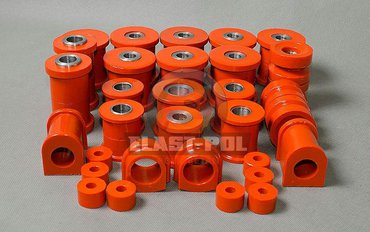Our certificates:
What is Polyurethane?
Polyurethane (elastomer) is a material with unlimited possibilities. It is used in sport and recreation, at home and in vehicles. Thanks to its characteristicks, PU improves life quality wherever it is used.
Polyurethane (elastomer) is among the most modern plastics. Because the material is extremely durable, the demand for them grows.
Polyurethane (elastomer) is irreplaceable in the automotive industry. It is several times stronger than standard rubber.
In addition, common rubber elements collide and grow old much faster and their rapid consumption causes so called floating of vehicle.
An alternative to rubber elements are made of polyurethane (elastomer), because it is a material with unlimited possibilities.
Basically PU consists of two materials, obtained from petroleum. Mixing of these ingredients and excipients produces a different chemical reaction. By changing the mixing ratio of the components can be precisely controlled properties of the resulting polyurethane, in order to obtain a material of different rigidity, flexibility, appropriate for individual needs.
Typical mechanical characteristics of polyurethane:
- hardness Shore 60-95
- tensile strength 13-52 MPa
- tensile strength 80-300 KN/m
- elongation at break of 250 to 600%
- resistance 20-65 %
- abrasion 20-130 mm³
- specific weight of 1-1.3 g/cm³
Benefits of polyurethane in automotive industry:
- extend tire life-time
- increase the number of kilometers between repairs
- increase driving safety
- effectively reduce operating costs
- maintain the stability of the suspension
- increasing the driving comfort
Why use our PU components?
We specialize in the production of polyurethane 17 years. We do not buy the finished products, but we synthetise our own.
Most companies that are on the market, makes the elastomer with basic components, without adding any additive. This is the result of material of lower quality.
Our product increases physical-chemical parameters, which are very important in the automotive industry.
We produce multi-component elastomer. Excluding basic components we add many other ingredients that improve the quality of the resulting polyurethane. The resulting polyurethane elements, annealing in an oven at 120 ° C for at least 24 hours, increases their properties.
Our product meets all the needs in the harshest tests of sports, competitions, events, as well as recreational riding.
For car enthusiast and people who like extreme advantage of the capabilities of their vehicles we offer perfect solution.
Our products are:
- high flexibility of the entire range of hardness
- high resistance to tear, rupture, abrasion
- very high toughness
- ability to work within a wide temperature range, positive and even negative
- UV resistance
- ability to function in other fats, oils, solvents and acids
- excellent vibration damping
- excellent feedback
- do not age (unlike rubber)
- non-flammable
How to replace Bushes:
1) remove arm/rod/stabilzer/etc.
2) remove old bushing
Warning:
in case of burning the old bush out, it is important to keep the outter sleeve!
3) remove any remaining barriers such as rust and rubber residues
4) lubricate hole
5) enter polyurethane bushing
6) lubricate the inner hole mountings and insert a steel sleeve, tighten the bolt through
Selection of polyurethane hardness:
We offer several polyurethane hardness, on a scale of 65 to 90 ShA.
When selecting the correct type of polyurethane in the suspension must be considered all the factors of the vehicle. Hardness is chosen according to the nature of their usage.
After obtaining information from the client on the usage of the vehicle, we choose hardness. Our goal and mission is to select the hardness of bushing that will provide the best control of the vehicle.
There are several types of polyurethane hardness:
Shore hardness scale:
This term refers to the statistical methods for measuring the hardness of rubber, elastomers and rigid plastics.
The inventor was Albert F. Shore, who developed a device called Durometer. Expressed in degrees Shore A (0-100).
There are several types of non-metallic materials durometer (A, C, D, 0, etc.).
Shore scale is mostly marked Shore, SHD, etc.
65 Shore A - soft, green colour:
75 Shore A - standart, orange colour:
- bushing on arms, panhard rods, stabilizers, etc.
85 Shore A - OFFROAD, blue colour:
- bushing, specialized on motor sport (rally, off-road competitions, etc.)
95 Shore A - hard, orange or blue colour:






